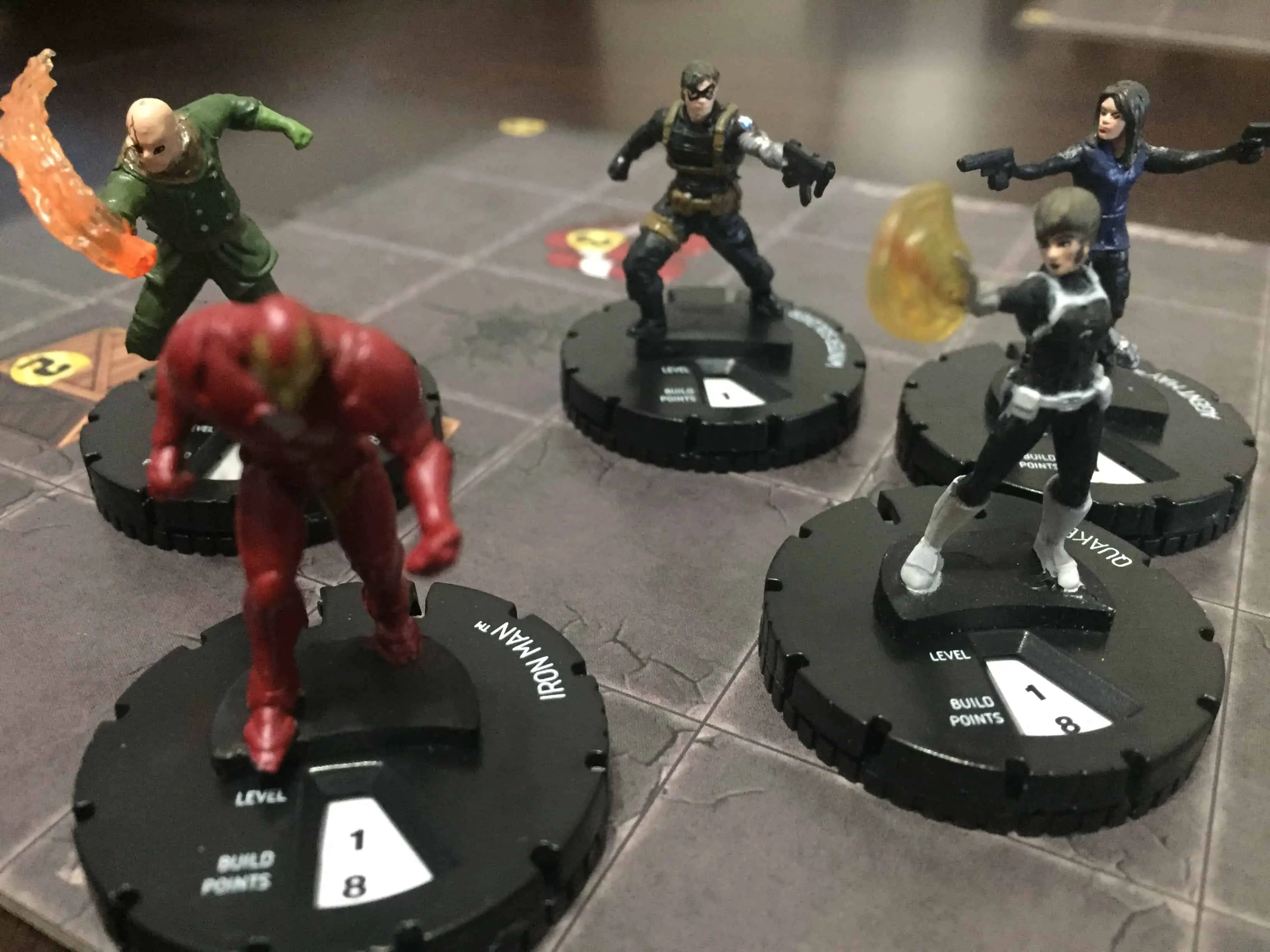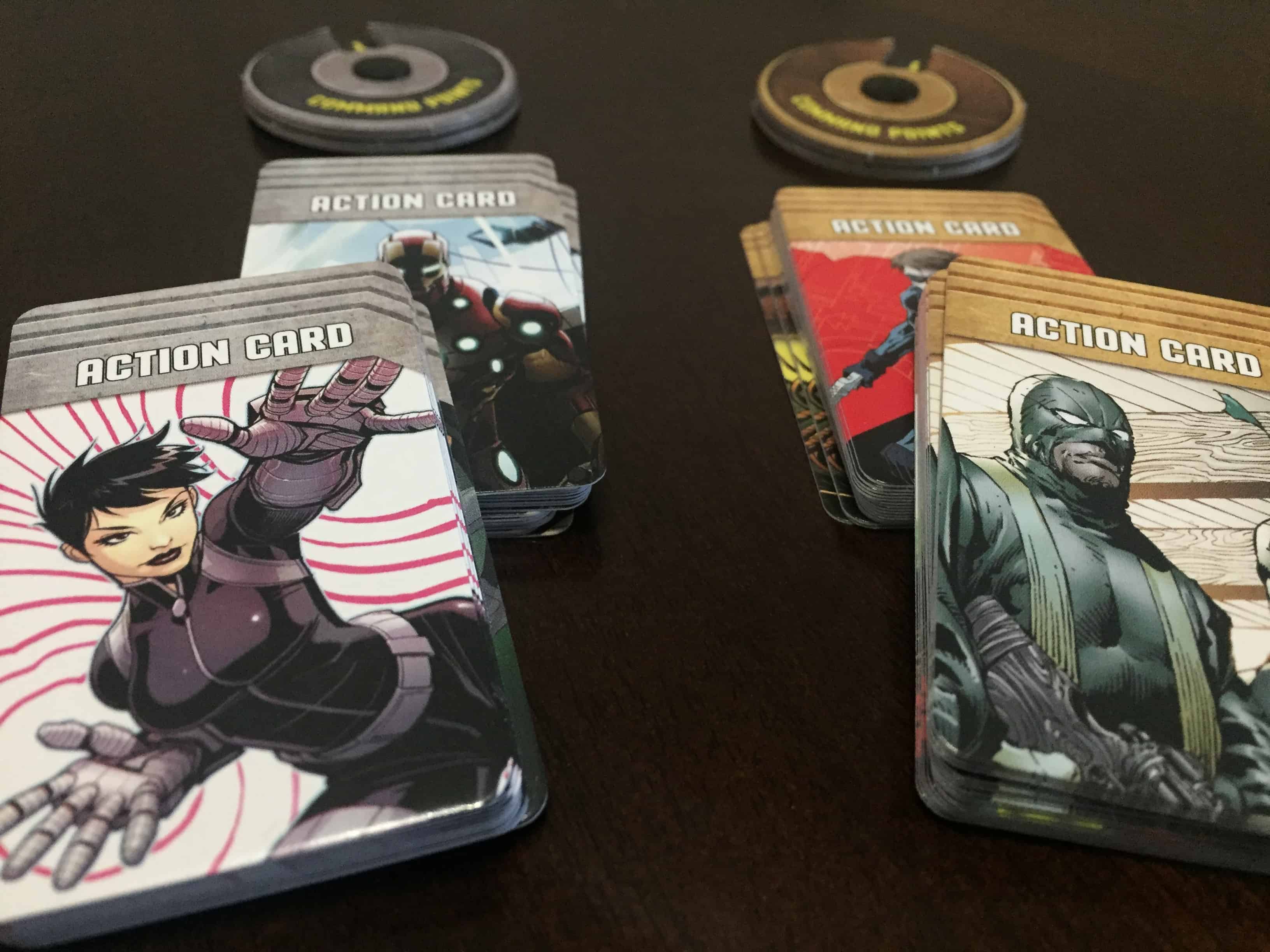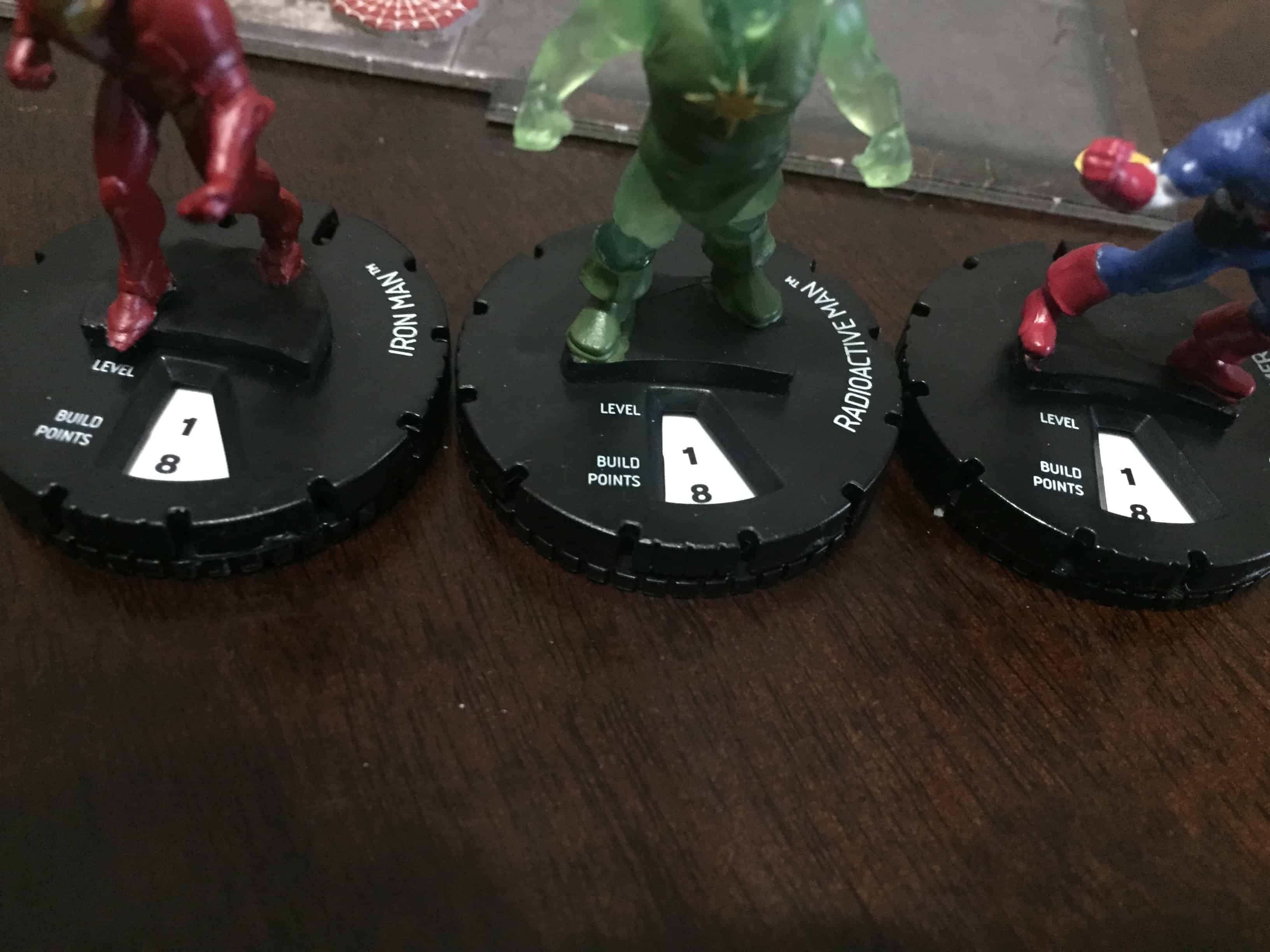Marvel Strike Teams is a scenario-based skirmish game in the Marvel Superhero universe, and also in the HeroClix line. It was designed by Andrew Parks and published by WizKids.

Marvel Strike Teams is something of a reboot and a return to roots, as well as being an evolution of the HeroClix system, all at once. Created and published in 2002, the original HeroClix skirmish game eventually grew to include just about every character in every popular comic, movie, or video game. Yet, it began as a Marvel game. Marvel Strike Teams returns HeroClix to the Marvel Universe, only in a brand spanking new reiteration with scenario-based missions and an overlord vs. players system (1 vs. many).
This is a completely separate beast from any HeroClix figures or accessories that might be on your shelf. Instead of a big beat-em-up, heroes and villains will attempt to thwart one another as they try to accomplish missions, like protecting an intergalactic entity or messing with the genetics of unwitting henchmen. Does the addition of scenario-based play represent a worthy move forward for the HeroClix franchise?
How to Play Marvel Strike Teams
1. Heroes and Villains
The base game of Marvel Strike Teams brings you four heroes – Captain America, Iron Man, Agent May and Quake (I suppose they are saving a lot of the heavier hitters for expansions). Each player gets the familiar figure with a HeroClix click-base. However, the Strike Teams bases have a lot fewer stats – only level and build points, neither of which influence gameplay.

Heroes also get a player mat with some small variations in attack, defense, and speed. Customization comes with each hero’s cards. Cards give you Cap’s shield tricks, Iron Man’s armor gadgetry, etc. Before each mission, depending on your level, you get a certain number of build points which you could use to swap card powers in and out.
The villains… work the exact same way! Usually in 1 vs. many games, you get pretty radical asymmetry between the opposing factions. Not so here – most of the villains (except for the gang of henchmen) can earn build points to get power ups, just like the heroes.

2. Gameplay
When you fire up a mission, the hero and mastermind players get the same number of “unit points”. So, if there are two hero players with a character each, the mastermind gets two villain characters. Against four players, the mastermind controls four villain characters.
At the start of any character turn, hero or villain, you will gain a set number of action points, depending on your character. You will use those action points to move, attack, and use your special powers. So far this sounds like… every dungeon crawl game ever. That’s not a bad thing, actually, since familiarity cuts down the barrier of entry for newer folks.

The action/ damage economy, as well as the card powers. wrinkle up what would be fairly straightforward gameplay. Damage isn’t in a separate pool like in most skirmish games: rather, damage gets placed on your power cards and character. As you gain more damage, your abilities become more expensive. A regular punch might cost 2 AP, for example, but having two cubes of damage on there will make it cost 4 AP.
This creates interesting, turn-by-turn decisions – should you go gonzo and try to take out an objective with all your AP, exposing yourself to damage on the mastermind turn? Or should you hold some back in order to defend against enemy attacks? Does the scenario demand that you push through all of your damage, or do you have time to rest and remove those cubes?
Actions carry over from turn to turn. So, if you gain five AP a turn, you can squirrel away a couple of actions every turn to enable a big nova turn later. Also, both sides earn Command Points every round. These provide give global AP to whichever team member wants or needs it the most.
I almost forgot… the die! You can roll to see if you get more actions, with a 1 in 3 chance that you will give your enemy an extra action. So, you get LOTS of ways to manipulate the action economy.
3. The Missions
Marvel Strike Teams comes with 18 missions, six for each of three stages. A full game spans three stages, so you are looking at being able to play six full multistage missions before you see any repeats. Also, the maps are not tied to the scenario – you can rescue the prisoner from any number of variations of warehouses and Hydra bases. In this way, Marvel Strike Teams gives you tons of variety out of the base box.

What I Liked About Marvel Strike Teams
1. It feels like Marvel (particularly due to the action cards)
True confessions: this was the first thing I looked for. If this was a good game that didn’t make me feel like my favorite heroes, I would have been severely disappointed. Thankfully, Cap does Cap things like protect his allies and toss his shield to hit multiple henchmen with it, ping pong style. Iron Man does Iron Man things like dash across the board and hand laser some fools. Different characters can hurl objects, achieve slippery movement, and do all sorts of thematic things that make this feel like a genuine Marvel-esque experience.

2. Action economy allows players to exert greater control over the ebb and flow of the game.
I love that the game system allows players to save actions for needed situations, either for defense or for more impactful turns later. The ability to save actions creates a lot of decision space within a turn. In addition, aside from your own actions, there’s also the global AP available via command points which can also help.
All of this comes together to make every turn interesting and reduce the feeling of “dead turns” – for example, where you might be juuuust too far away from something to do anything useful. You can bank those actions, rather than waste them.
The only thing that can really slow you down is damage. More on that later.
3. Enough scenario variability
With 18 mission cards enabling 6 full missions with no repeats, along with the fact that various maps are not tied to the scenario and can be swapped around, you really do get a lot different looks here. I wouldn’t say the missions radically differ from one another. However, I never felt truly bored with any of the missions.
I wish the base box included more characters (especially heroes, since Marvel is all about heroes). You end up seeing all of the hero content quickly, especially at higher player counts. But relative to other dungeon crawls like Descent, what you get here is comparable.
4. A great 1v1 experience
The unit point system I described above means that the mastermind (which is always one player) has access to as many units as the hero does. Because the heroes and villains work the same, a hero player controlling two characters vs a villain player controlling the same, or one character and a few henchmen, turns into a nice, even, Mano-a-Mano battle.

What I Didn’t Like about Marvel Strike Teams
1. Questions about the scaling system
When I pointed out that I like Marvel Strike Teams as a 1v1, I suppose that was only half of a compliment. I found that the experience wasn’t as satisfying at higher player counts. At 2-4 Hero players, they only ever control their own hero. The mastermind, however, gains units right along with the player.
The result is that, at higher player counts, the mastermind player has a LOT more to do; against 204 players, the mastermind’s turn increased by the same amount. I’ve experienced 4 player games where the players had fun but the mastermind felt overwhelmed. I’ve also seen the other side, where the mastermind loved all the options available while the players felt bored with their one hero. Either way, something feels wrong with the scaling.
In many other 1 vs. Many games, the mastermind player has more to do. However, most of their units are usually simple and only really there to get in the heroes’ way. Here, even the henchmen have power cards (including a fairly devastating concussion rocket that matches a lot of what the heroes can do), and they get more powerful and complex along with everyone else.
2. Damage/ action system sometimes felt frustrating
This is another issue I found that emerged in higher player counts. A mastermind could use their turn to successfully focus attacks at one hero, which essentially locks them out of their next turn. As mentioned above, many skirmish/ dungeon crawler games treat damage and AP separately. They either don’t interact at all or, as sometimes happens in basic HeroClix battles, damage makes the unit stronger! Here, damage is almost always bad for the receiver.
Marvel Strike Teams offers lots of damage mitigation, to be sure. You can improve tactics to provide cover for wounded units, or provide wounded characters with command points to help them get going. Or, if you know you’re likely to get hosed, you can save AP for defense. However, does this all make sense within the context of a superhero game? Some of my games ended up feeling like battles of attrition, which isn’t the feeling I wanted here.

To be clear, I think the damage/ action mechanisms work fine. I wonder about the fun factor.
3. Not really HeroClix
In basic HeroClix, the click base gives a lot of info, much of which affects the basic game. However, the click bases in Strike Teams are so general, they are actually all exactly the same for every single character. Do I really need a click base to track my character’s level across missions? Can I not just use a die, or write it down somewhere? I suppose using HeroClix is good for branding. I’m not sure how much else it adds here.

Conclusion
I struggled with some aspects of Marvel Strike Teams, especially at higher player counts. However, on the whole, it successfully recreates the feel of playing my favorite Marvel characters doing heroic missions. I recommend Marvel Strike Teams for any gamer who can’t get enough Marvel, or who wants to explore some clever takes on action economy in a scenario-based skirmish system.




Show Comments